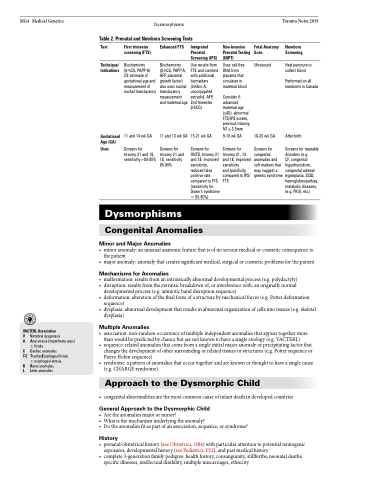Page 662 - TNFlipTest
P. 662
MG4 Medical Genetics
Dysmorphisms
Toronto Notes 2019
Table 2. Prenatal and Newborn Screening Tests
Test
Technique/ Indications
Gestational Age (GA)
Uses
First trimester screening (FTS)
Biochemistry (β-hCG, PAPP-A) US estimate of gestational age and measurement of nuchal translucency
11 and 14 wk GA
Screens for
trisomy 21 and 18, sensitivity=80-85%
Enhanced FTS
Biochemistry (β-hCG, PAPP-A, AFP, placental growth factor) also uses nuchal translucency measurement and maternal age
11 and 13 wk GA
Screens for trisomy 21 and 18, sensitivity 85-90%
Integrated Prenatal Screening (IPS)
Use results from FTS and combine with additional biomarkers (inhibin A, unconjugated estradiol, AFP, 2nd trimester β-hCG)
15-21 wk GA
Screens for ONTD, trisomy 21 and 18; improved sensitivity, reduced false positive rate compared to FTS (sensitivity for Down’s syndrome = 85-90%)
Non-Invasive Prenatal Testing (NIPT)
Uses cell-free DNA from placenta that circulates in maternal blood
Consider if: advanced maternal age (≥40), abnormal FTS/IPS screen, previous trisomy, NT ≥ 3.5mm
9-10 wk GA
Screens for trisomy 21, 13 and 18; improved sensitivity
and specificity compared to IPS/ FTS
Fetal Anatomy Scan
Ultrasound
18-20 wk GA
Screens for congenital anomalies and soft markers that may suggest a genetic syndrome
Newborn Screening
Heel puncture to collect blood
Performed on all newborns in Canada
After birth
Screens for treatable disorders (e.g.
CF, congenital hypothyroidism, congenital adrenal hyperplasia, SCID, hemoglobinopathies, metabolic diseases, (e.g. PKU), etc.)
Dysmorphisms
VACTERL Association
V Vertebral dysgenesis
A Anal atresia (imperforate anus)
± fistula
C Cardiac anomalies
T-E TracheoEsophagealfistula
± esophageal atresia R Renal anomalies
L Limb anomalies
• minoranomaly:anunusualanatomicfeaturethatisofnoseriousmedicalorcosmeticconsequenceto the patient
• majoranomaly:anomalythatcreatessignificantmedical,surgicalorcosmeticproblemsforthepatient
Mechanisms for Anomalies
• malformation:resultsfromanintrinsicallyabnormaldevelopmentalprocess(e.g.polydactyly)
• disruption:resultsfromtheextrinsicbreakdownof,orinterferencewith,anoriginallynormal
developmental process (e.g. amniotic band disruption sequence)
• deformation:alterationofthefinalformofastructurebymechanicalforces(e.g.Potterdeformation
sequence)
• dysplasia:abnormaldevelopmentthatresultsinabnormalorganizationofcellsintotissues(e.g.skeletal
dysplasia)
Multiple Anomalies
• association:non-randomoccurrenceofmultipleindependentanomaliesthatappeartogethermore than would be predicted by chance but are not known to have a single etiology (e.g. VACTERL)
• sequence: related anomalies that come from a single initial major anomaly or precipitating factor that changes the development of other surrounding or related tissues or structures (e.g. Potter sequence or Pierre-Robin sequence)
• syndrome:apatternofanomaliesthatoccurtogetherandareknownorthoughttohaveasinglecause (e.g. CHARGE syndrome)
Approach to the Dysmorphic Child
• congenitalabnormalitiesarethemostcommoncauseofinfantdeathindevelopedcountries
General Approach to the Dysmorphic Child
• Aretheanomaliesmajororminor?
• Whatisthemechanismunderlyingtheanomaly?
• Dotheanomaliesfitaspartofanassociation,sequence,orsyndrome?
History
• prenatal/obstetricalhistory(seeObstetrics,OB4)withparticularattentiontopotentialteratogenic exposures, developmental history (see Pediatrics, P22), and past medical history
• complete3-generationfamilypedigree:healthhistory,consanguinity,stillbirths,neonataldeaths, specific illnesses, intellectual disability, multiple miscarriages, ethnicity
Congenital Anomalies
Minor and Major Anomalies


